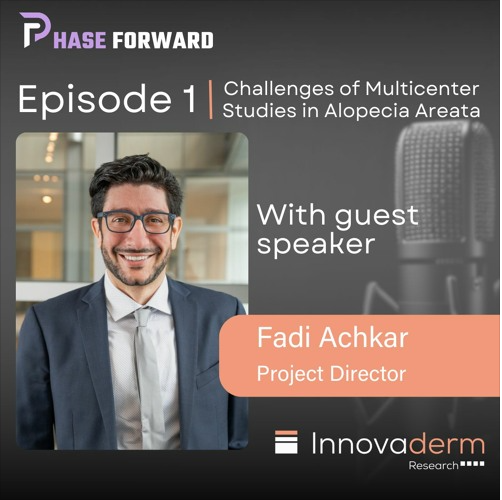 Episode Notes
Episode Notes
Resources:
- [email protected]: Use this email to let us know what you want to hear about.
- Dr. Robert Bissonnette and Dr. Kim Papp on Alopecia Areata Studies Insights
——-
Joining us today is a seasoned project director with more than 15 years’ experience in the industry. We dive into a particular particularly important area of research. The challenges of multi-center studies in alopecia areata. We will be exploring 3 crucial pain points in our discussion:
- Patients severity
- The subjective nature of the Severity of Alopecia Tool (SALT)
- The unmet needs in alopecia areata (AA)
Alopecia Areata, the Condition
AA is a condition where an individual experiences hair loss in round patches on the scalp or other parts of the body. It is an autoimmune disorder and can impact anyone, regardless of their gender or age.
Severe AA Patients: Participation vs. Sustainability in Studies
There are varying degrees of hair loss due to AA, which are measured using the Severity of Alopecia Tool (SALT). The higher the SALT score, the greater the hair loss. We have observed that many of our patients with higher SALT scores, indicating more hair loss, are often more interested and available for clinical trials, and are more aware of ongoing trials.
However, we cannot limit our studies to only these patients. When hair loss exceeds a certain level, it becomes more difficult for hair to regrow. If we are testing a drug in a proof-of-concept (POC) study, we would also want patients with moderate severity, to determine if the drug can indeed stimulate hair regrowth.
A common practice is to implement a cap to maintain balance. We design the study to include a certain number of patients with Alopecia Totalis or Universalis (SALT 100) or near full hair loss (SALT 99), and the rest of the patients are from the lower SALT ranges, typically starting from SALT 50. This approach ensures a balanced trial and contributes to its success.
Severe AA Patients: Multi-Centers Studies
This is interesting because when we conduct a study across multiple sites with a limited number of subjects capped at 100, a certain level of competition arises. This competition is beneficial to increasing enrollment rate and advancing research. It is crucial that we actively notify sites as we approach or reach the predetermined cap. A multisite strategy also aids in distributing the inherent subjective variability when evaluating SALT scores. For instance, if there are few sites, one site might skew the results due to consistent underestimation of SALT scores. While we ensure that adequate training is provided and consistency is maintained throughout the study, having a multi-site trial allows us to prevent a single site from recruiting many patients, thereby ensuring a more balanced distribution across sites.
Evaluating Hair Loss: The Subjectivity of SALT
While SALT is a subjective measure, it is thoroughly documented. Investigators are provided with comprehensive training, including a quiz, before they can use this measure in clinical trials. It is not a tool typically used in their regular clinical practice when they might simply classify hair loss as severe or moderate without assigning a specific number. SALT addresses this by dividing the head into four quadrants. Each quadrant is evaluated for the extent of hair loss, and a weighted average is then used to calculate a total hair loss score. A score of 100 indicates complete hair loss, while a score of 90 signifies 90% hair loss across the scalp. Eyebrow and eyelash hair loss measures are also often included, for which site assessors are also trained.
Challenges and Opportunities in the Landscape of Approved Treatments
Until last year, there were no treatments specifically approved for AA in the United States or Canada. While other treatments were in use, none had received direct approval. However, 2 years ago, we began to see the approval of treatments in the form of JAK inhibitors.
These treatments have shown success, and one of them has now been approved in Canada. This is exciting news as it signifies groundbreaking progress. The landscape is evolving, but this does not mean the end of other clinical trials. There is still ample opportunity for new drugs and different administration methods, not necessarily orally administered such as JAK inhibitors, but perhaps subcutaneous with less frequent dosing. We are eagerly anticipating more clinical trials in this area.
To conclude this conversation, we are looking forward to seeing you at the upcoming AAD in March. I will be there in person, Innovaderm is hosting a breakfast to discuss AA. See you there!
As we conclude another illuminating episode of Phase forward, we find ourselves at the crossroads of science and progress. Remember that behind the jargon in statistics lies stories of unwavering commitment, meticulous observation, and the pursuit of evidence that shapes our understanding of health and disease, stay at the forefront of knowledge and innovation, and follow. Phase forward on your preferred platform. My name is Valerie Coveney. Thank you for joining us. Until next time.
Let’s shape the future of research and make a difference in the industry, gain Innovaderm’s support in your upcoming trial and propel your study to new heights

